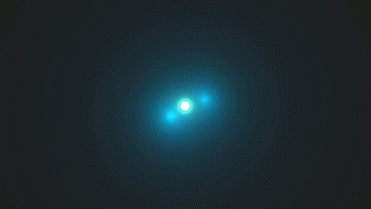The Helium Atom

The Helium Atom
Helium nuclei were created in the Big Bang and contain two protons and two neutrons each. Helium is the second most abundant element, comprising roughly one quarter of the mass of the Universe. This animation zooms into a standard helium atom, showing its protons (green), neutrons (white), and electrons (blue).
Credits: Dana Berry / Lead Animator Michael McClare (HTSI)
More Posts from Ricardocedillob and Others

Catherine Deneuve





Types of matter

by Daichin Khu

Ford Coupe ( 1935 ) 3 window. 😁

PRE WAR

Hindenburg at the U.S. Navy hangar, Lakehurst, New Jersey, 1936.

ONE YEAR LATE
In this 1937 photo, the passenger-carrying airship Hindenburg is seen at the moment of exploding midair in Lakehurst, New Jersey. The disaster claimed the lives of 36 and marked the end of the era of passenger-carrying airships.










Ask Ethan: Why don’t comets orbit the same way planets do?
“Why [do] comets orbit the Sun in a parabolic path, unlike planets which orbit in an elliptical one? Where do comets get the energy to travel such a long distance, from the Oort cloud to the Sun & back? Also, how could interstellar comets/asteroids come out of their parent star [system] and visit other ones?”
When we see comets in our Solar System, they can be either periodic, passing near the Sun and then extending very far away, to return many years later, or they could be a one-shot deal. But comets are driven by the same gravitational laws that drive the planets, which simply make fast-moving, nearly-circular ellipses around the Sun. So what makes these orbits so different, particularly if they’re obeying the same laws? Believe it or not, most of the would-be comets out there are moving in exactly the same nearly-circular paths, only they’re far more tenuously held by the Sun. Gravitational interactions might make small changes in their orbits, but if you’re already moving very slowly, a small change can have a very big effect!
Why don’t comets orbit the same way as the planets? Find out on this edition of Ask Ethan!


Fossil Fish Skull (Xiphanctinus audax, Cretaceous) - Niobrara Formation, Kansas
This sinister looking skull once belonged to a predatory fish that dominated the Western Interior Seaway known as Xiphactinus which was much longer than any bony fish of today. The beast is represented here by just a skull and some post-cranial material, but the point gets across nonetheless.
-
 doomwhathouwilt liked this · 3 years ago
doomwhathouwilt liked this · 3 years ago -
 oldvision reblogged this · 4 years ago
oldvision reblogged this · 4 years ago -
 blaster-master liked this · 4 years ago
blaster-master liked this · 4 years ago -
 master24s liked this · 4 years ago
master24s liked this · 4 years ago -
 dopamine-cloud reblogged this · 5 years ago
dopamine-cloud reblogged this · 5 years ago -
 sagasaleissont liked this · 5 years ago
sagasaleissont liked this · 5 years ago -
 cassrielghost reblogged this · 5 years ago
cassrielghost reblogged this · 5 years ago -
 lu-2a liked this · 5 years ago
lu-2a liked this · 5 years ago -
 fallen549 liked this · 5 years ago
fallen549 liked this · 5 years ago -
 fagdykefrank liked this · 5 years ago
fagdykefrank liked this · 5 years ago -
 clara8pie liked this · 5 years ago
clara8pie liked this · 5 years ago -
 daisylovesrumble liked this · 5 years ago
daisylovesrumble liked this · 5 years ago -
 bots-have-better-names liked this · 5 years ago
bots-have-better-names liked this · 5 years ago -
 gia-is-a-punk-rocker liked this · 5 years ago
gia-is-a-punk-rocker liked this · 5 years ago -
 a-golden-bear liked this · 5 years ago
a-golden-bear liked this · 5 years ago -
 tarakizart liked this · 5 years ago
tarakizart liked this · 5 years ago -
 16fahri liked this · 5 years ago
16fahri liked this · 5 years ago -
 smallfryingpan liked this · 5 years ago
smallfryingpan liked this · 5 years ago -
 kvethashurtugal liked this · 5 years ago
kvethashurtugal liked this · 5 years ago -
 gingerfan24 liked this · 5 years ago
gingerfan24 liked this · 5 years ago -
 mecca-mocca-tobacco reblogged this · 5 years ago
mecca-mocca-tobacco reblogged this · 5 years ago -
 mecca-mocca-tobacco liked this · 5 years ago
mecca-mocca-tobacco liked this · 5 years ago -
 center-for-chthonic-studies liked this · 5 years ago
center-for-chthonic-studies liked this · 5 years ago -
 gffeisty liked this · 5 years ago
gffeisty liked this · 5 years ago -
 weemeedtoalkaboutlevinofeternity liked this · 5 years ago
weemeedtoalkaboutlevinofeternity liked this · 5 years ago -
 lumosnite liked this · 5 years ago
lumosnite liked this · 5 years ago -
 speedrunner-fuchs-wulf liked this · 5 years ago
speedrunner-fuchs-wulf liked this · 5 years ago -
 thecozynerd liked this · 5 years ago
thecozynerd liked this · 5 years ago -
 eastern-wind liked this · 5 years ago
eastern-wind liked this · 5 years ago -
 phoenix-the-unbreakable liked this · 5 years ago
phoenix-the-unbreakable liked this · 5 years ago -
 bamboozledbees reblogged this · 5 years ago
bamboozledbees reblogged this · 5 years ago -
 ginakims-world-blog reblogged this · 6 years ago
ginakims-world-blog reblogged this · 6 years ago -
 chrishansenfromdatelinenbc liked this · 6 years ago
chrishansenfromdatelinenbc liked this · 6 years ago -
 agentsstr liked this · 6 years ago
agentsstr liked this · 6 years ago -
 negrodaumus reblogged this · 6 years ago
negrodaumus reblogged this · 6 years ago -
 zyin reblogged this · 6 years ago
zyin reblogged this · 6 years ago -
 maddmazel reblogged this · 6 years ago
maddmazel reblogged this · 6 years ago -
 missnewswoony reblogged this · 6 years ago
missnewswoony reblogged this · 6 years ago -
 resilientbeauty reblogged this · 6 years ago
resilientbeauty reblogged this · 6 years ago -
 red-curb liked this · 6 years ago
red-curb liked this · 6 years ago -
 roropcoldchain reblogged this · 6 years ago
roropcoldchain reblogged this · 6 years ago